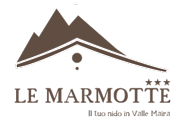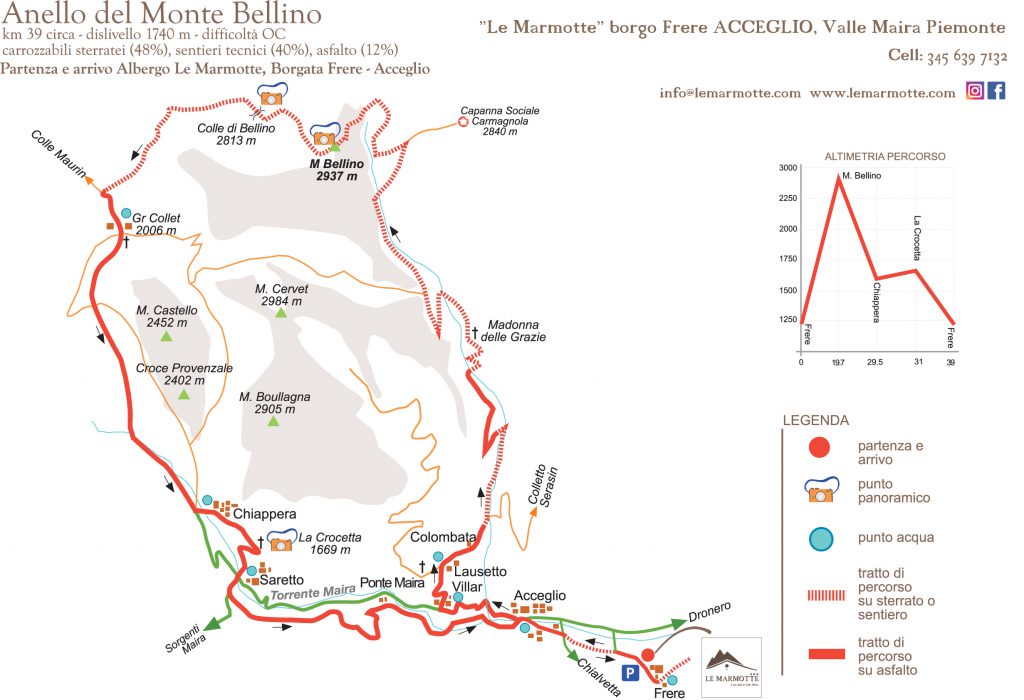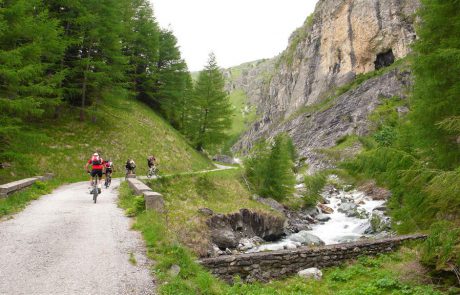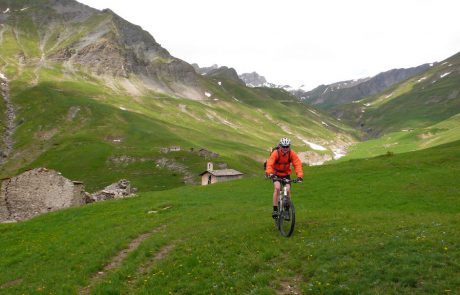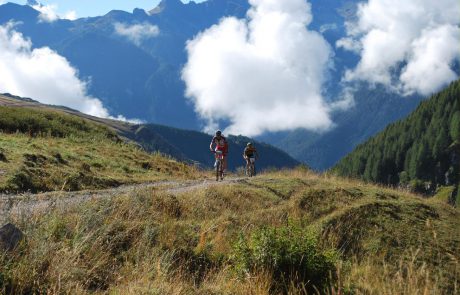THE LOOP ROUTE OF MONTE BELLINO -OC
Photos
Good, after a rich breakfast you are ready to head out. No cars! You leave directly from here on your MTB.
The loop is characterized by the long climb up to 2942 meters of Mount Bellino; the climb does not present particular technical difficulties, but it turns out to be quite long and with a respectable elevation gain.
Leave the Marmotte Hotel and proceed in the direction of Acceglio along a dirt track that traces back to the right of the Maria stream.
From Acceglio go uphill and pass the villages of Villaro, Lausetto and Colombata where, just beyond, the paved road becomes a dirt road near a bridge on the Rio Mollasco.
Keep cycling uphill to the little church of Madonna delle Grazie (1994 m) and, after a long way, you reach the Carmagnola refuge (2830 m).
Near the last curve, the Colletta (2830 m), on the left side you will notice a small path that climbs halfway up until a fork; turn right to reach the summit of M. Bellino (2942 m) – you’ll need to carry the MTB for about 100 meters in elevation.
You have arrived at the panoramic destination! A bit of effort but it was worth it, right?
Time for photos! Snap away and share with our hashtag:
#albergolemarmotte #vallemairabikeexperience #mairavigliosa
For the descent, follow the single trails, initially gravelly, to the Bellino pass and from here take the slope to Vallone del Maurin.
Resume pedaling once you reach the large and fast dirt road near the Grange Collet until b. ta Chiappera (1614 m) where you follow the P.O. yellow markings to reach La Crocetta and then go downhill to borgata Saretto.
The dirt road on the right bank of the Maira river takes you to Borgata Ponte Maira, Acceglio and then to Frere, avoiding the pavement.
You have returned to the Marmotte Hotel. Today’s excursion is over. Good Job!
Now you can enjoy a well deserved rest in the garden, sipping a nice cold beer!
Equipment
The routes usually start in high alpine environments and at a high altitude which are subject to rapid climatic change. You need clothing which allows you to adjust for these changes.
Before you leave, be sure to check that you have (either by wearing or carrying a pack) these three basic items:
- UNDERWEAR LAYER: The layer against the skin must allow for air circulation, and must wick moisture away from the body quickly.
- MIDDLE LAYER: The second layer must provide insulation while also allowing moisture to escape.
- OUTER LAYER: The outermost layer must provide protection from the elements such as wind and rain, while still allowing the body to breath and moisture to escape.
While some people consider helmets annoying and ugly, they without a doubt are essential.
Before leaving, be sure to adjust the helmet for total enjoyment.
They are very useful for protecting your eyes from the atmospheric elements.
It is important that they firmly enclose your face so you never need to remove your hands from the ski equipment.
The very best lenses are photochromic: designed to adapt to different kind of lights.
Using gloves is a very good habit because they ensure correct grips on equipment and the cushioning in the palms absorbs vibrations for a more pleasant run.
These basic items will limit injury in the case of a fall.
Short ones or long ones… are personal choices.
One or more of these should be filled before setting out.
Always check a map for water points along your path.
When choosing a backpack lightness and comfort are especially important. The backpack, in addition to carrying things, must also provide optimal distribution of the weight of items .
Before setting out, adjust all the straps and tension bands.
The ideal backpack for a day of MTB should have a capacity of 25-30L with a series of useful pockets to separate the following:
– clothing (wind-breaker, undershirt, long gloves, batteries, sun creams, etc.)
– food (energy bars, fruit, supplements, etc.)
– First Aid Kit (gauze, bandages, scissors, gloves, disinfectant, cotton bandage roll, thermal towel,etc..
– Accessories or emergency mechanical parts air chambers, cans, brake wire, adhesive tape, multi-purpose key, beagle levers, pliers, pump …)
–Various accessories (topographical maps, multi-function knife, GPS, head lamp, cellphone, camera, etc.)
During an excursion, it is advisable to have a working cell phone with you (even if turned off) with a fully charged battery.
The number to call in case of an emergency is “112”.
Emergency services might need to arrive by helicopter; in this case:
- Find a clear landing area.
- If possible, signal your position to the pilot by waving your arms.
- Make sure the injured part is in an area clear of debris or material that could be shifted by the helicopter.
BEHAVIOUR STANDARDS:
The courses are open to everyone, and much appreciated by trekkers.
– It is good practice to moderate your speed for others, and to free the passage to people on foot going in the opposite direction.
-Also, crossing alpine pastures requires caution. Dogs protecting flocks of sheep can be aggressive if you do not get off the bike or if you come too close to the sheep.
